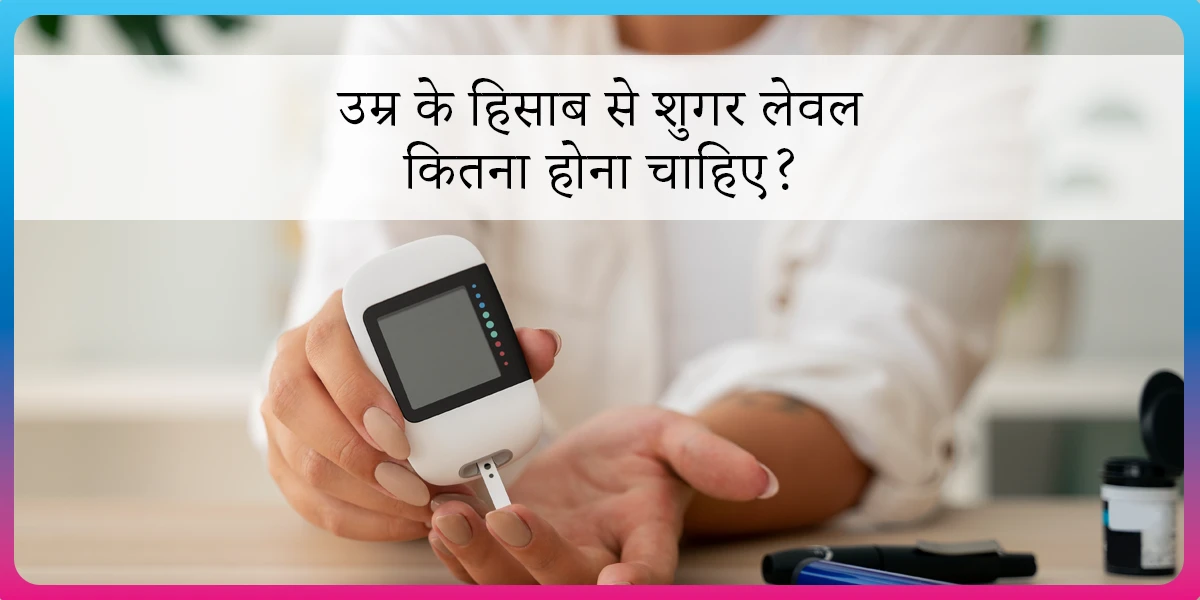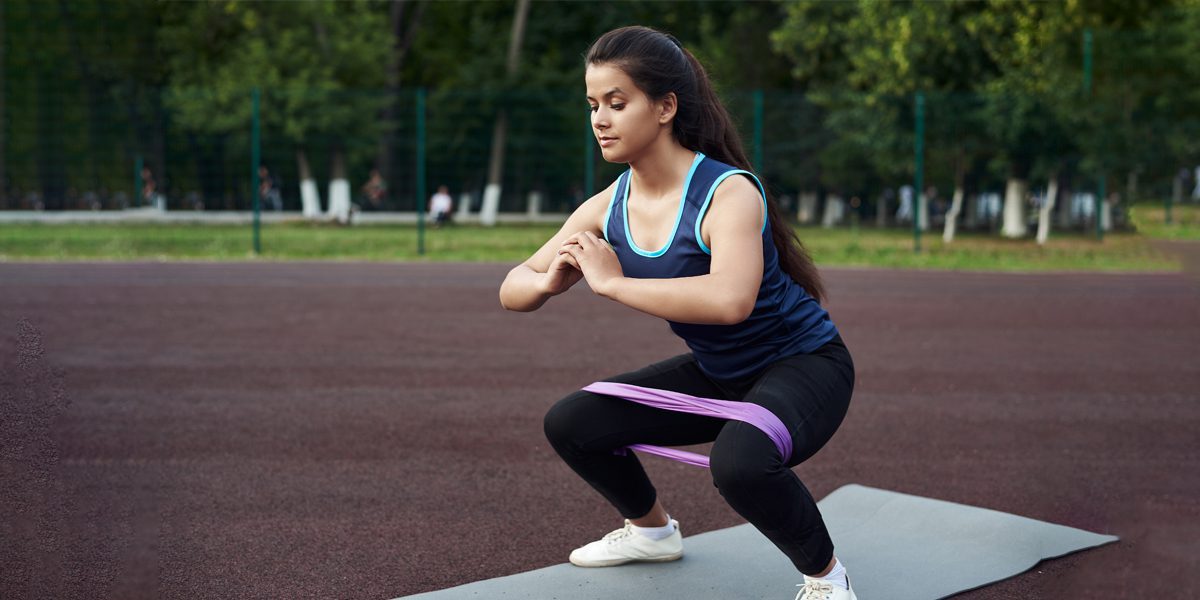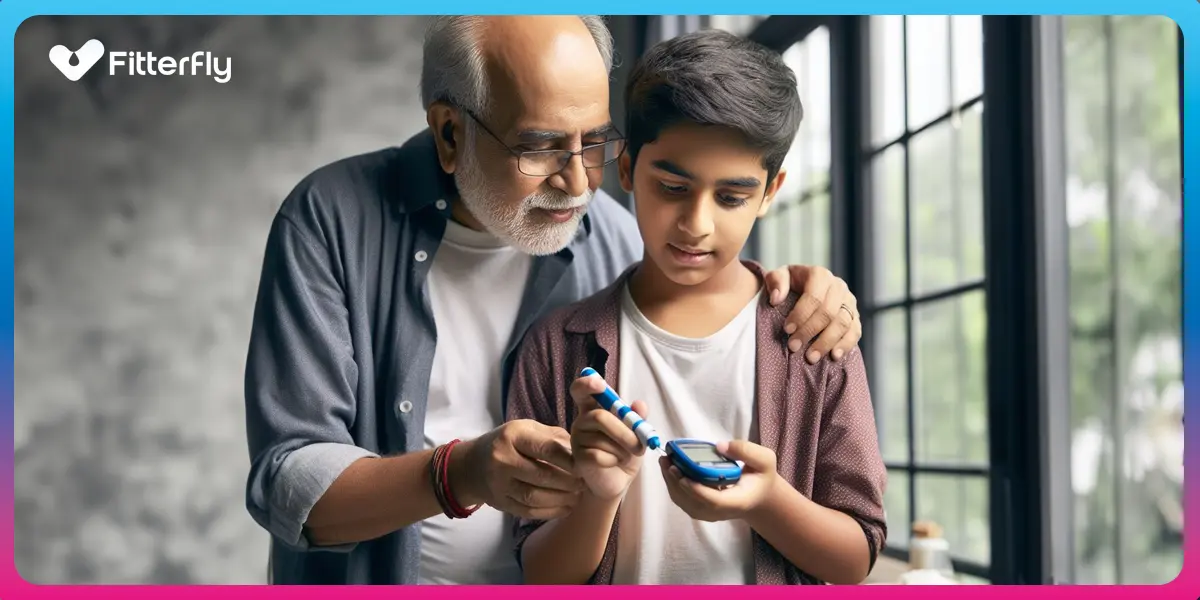Your CGM Guide: Managing Diabetes with Continuous Glucose Monitoring

Imagine you have just had your favourite meal, maybe a plate of yummy rajma chaawal or dum biryani or pav bhaji dunked in butter!
HEAVENLY!
Now it’s inside your tummy but how would you know how much that lip-smacking dish has affected your blood sugar levels, especially if you have diabetes?
Well, we all know the traditional method of measuring glucose. The traditional method involves the usage of a glucometer using blood after a finger prick and applying it on a glucometer strip.
You also may come across the term continuous glucose monitoring (CGM), and might be thinking of what does a CGM measure? or what is CGM in diabetes?
Thanks to a recent technology – Continuous Glucose Monitoring System (CGMS), we have the latest aid in diabetes management. Do you want to know the purpose of this innovation? It’s to make diabetes management as simple as possible!
With CGM measuring or monitoring your glucose level doesn’t have to be challenging or hurtful.
If you want to know more about this contemporary continuous glucose monitoring device, here’s a simple beginner’s guide to understanding CGM and its workings! Let’s begin!
What is Continuous Glucose Monitoring (CGM)?
A continuous glucose monitoring system is a coin-sized and advanced wearable device that helps you to measure/monitor your blood glucose level for 14 days.
Most CGMs are designed with a small sensor to be worn under the arm or belly. It can be used for 14 days (2 weeks), even when you sleep.
How does a continuous glucose monitor (CGM) work?
There is a tiny sensor in the CGM that measures how much glucose is present in the interstitial fluid surrounding the cells or tissues every few minutes.
When we mention the types, different CGM devices are available in the market with unique features. You can consult your doctor/diabetologist to choose the right one.
Who should consider using a CGM device?
- Anyone can use a continuous glucose monitoring device – because monitoring your blood sugar levels will help you achieve your overall health goals.
- It is used more by people with diabetes because they have a greater need to monitor their blood glucose levels more frequently.
- Typically, continuous glucose monitoring (CGM) is used by individuals who experience great variations in their blood sugar levels.
However, it is used more by people with diabetes because they have a greater need to monitor their blood glucose levels more frequently. With the help of your phone or reader, you can get accurate data within minutes.
They can be an excellent aid for people who are frequently traveling. You can easily view the patterns of your glucose level via a tablet or smartphone.
To know your chances of Diabetes reversal, take the Diabetes Reversal TestDiabetes Reversal
Calculator
Why do people with diabetes need to track blood sugar levels?
- People with diabetes need to track their blood sugar levels to monitor their glycemic control and prevent glucose variability, which in turn can prevent complications related to diabetes.
- It will allow you to know how your blood glucose level responds to different food groups to avoid sudden spikes and lows. For instance, for certain people, millets are a healthy food option, while for others, it could be the reason for high blood sugar.
- It can also help identify patterns and trends in blood sugar levels, which can prevent fluctuations in blood sugar levels, and it can also help in help in adjust in treatment plans.
- On the other hand, people can also use continuous glucose monitoring (CGM) while exercising to know the variations in their blood glucose levels.
- Simply put, you can use a CGM device even if you don’t have diabetes and make better food choices.
How to use a continuous glucose monitoring (CGM) device?
- A small sensor is applied over the back of your upper arm to use a CGM device. The sensor is connected to a transmitter that sends information to a receiver or smartphone.
- The user can view their glucose level, what it has been, what it is at that moment, and which way it’s heading.
- The user can adjust their insulin dosing based on numbers and trend arrows. The device requires calibration with fingerstick glucose.
What is the appropriate age to use CGM?
Now you may wonder, “Is CGM easy to use for any age group?”
Yes, anyone can use a continuous glucose monitoring (CGM) device.
The FreeStyle Libre 3 and FreeStyle Libre 2 systems are cleared for children with diabetes ages 4 and over, so you and your child can experience the benefits of CGM.
Advantages of using CGM as compared to other ways of managing diabetes
Is CGM needed to manage diabetes effectively? CGM improves the quality of life, whether it’s for diabetes or not.
1) No more pricks
no one likes getting pricked. Using a continuous glucose monitoring (CGM) device helps you get rid of those nasty pricks and make diabetes management a simple process.
2) Make better choices
CGM is a smart device that helps you make better choices on diet and lifestyle changes to support your longevity and well-being physically and mentally.
3) Learn about glycemic variability
Glycemic variability is a medical term indicating the spikes in your blood glucose curve. Ideally, we want our glucose levels to have a smooth transition, wherein they should only rise slightly after meals. If you have frequent spikes and crashes, you have high glycemic variability.
Because of the roller coaster effect, you may have a bad mood, poor energy, and long-term impacts. In this situation, when you have continuous glucose monitoring (CGM), you can easily monitor the variance in the blood sugar level and take the essential steps to control it.
4) Know the response to every food group (Personalized Glycemic Response – PGR)
Blood sugar responds differently to various food sources. For example, rice might spike your blood sugar more than a roti.
The reason – Glycemic Index of these Indian staples
The reaction varies depending on your overall health, sleep, stress, gut health, and genes. Simply reading the food’s carb content is insufficient to maintain the ideal sugar level.
But if you use a CGM device, you can make healthy changes to your dietary choice, like adding low-glycemic foods, based on the results, to maintain a stable glucose level.
Limitations of Continuous Glucose Monitor (CGM)
CGM is a great innovation for managing Diabetes with very few limitations. A few of them are:
1. Delayed readings
CGM devices measure glucose levels in interstitial fluid, which can lag behind blood glucose levels by about 15-20 minutes. This means that CGM readings may not reflect immediate changes in blood sugar levels.
2. Sensor insertion discomfort
Inserting the CGM sensor under the skin can cause slight discomfort or a pinching sensation. However, once the sensor is in place, it is generally comfortable and should not cause ongoing pain.
3. Cost and insurance coverage
Continuous glucose monitoring (CGM) devices can be costly and vary by type and make.
4. Calibration and maintenance
CGM devices require calibration with fingerstick glucose to ensure accuracy. Additionally, sensors must be replaced periodically, typically every 7-14 days, depending on the device.
REVERSED Diabetes in 3 months


5.7%
Happy members
EMI
Guarantee
4.8/5
Diabetes Prime Program
FitterTake
Keeping your blood glucose level under control and within the safe range is essential for effective diabetes management and avoiding further complications.
That’s how the continuous glucose monitoring device comes into the picture as the next-generation technological product, making it simple and easier to monitor your blood sugar level in the comfort of your home.
Now that you have ready and direct access to your blood sugar level history, how can you start making better lifestyle changes? #WorryNot – The change starts right here with the Fitterfly Diabetes Care Program. We help you evaluate every food you consume, the type of activity, stress management, and other chronic illnesses.
Given the pattern and trends, we help you create a personalised approach. Additionally, through our scientifically proven methods which involve intensive behavioral changes, we guide you on how you can manage your condition more efficiently.
Take a free consultation with one of our expert coaches to learn how we can help you manage your diabetes and take control of your life.
Call us on 08068507599, to know more.
This blog provides general information for educational and informational purposes only and shouldn't be seen as professional advice.
Frequently Asked Questions
How much do CGM devices cost?
The cost of CGM devices varies, but it usually costs around INR 5,000. It might vary depending on the brand type and device’s features.
Can people travel using a CGM sensor?
Yes, people can travel with a wearable continuous glucose monitoring (CGM) easily. People who are wearing the device can even walk through the metal detectors at the airport. However, ensure not to expose the device to hand luggage scanners as the X-rays can damage the device.
Is it possible to bathe or swim while wearing a CGM?
The CGM sensor is designed to be water-resistant but not waterproof. You can sweat or shower with CGM on, but it is not recommended to swim or expose the device to water for more than 30 minutes. Nonetheless, make sure to protect the device to ensure it does not get damaged.
Can a CGM sensor give wrong readings?
Although a CGM sensor is a smart device for diabetes management, there will be variations when you compare it with lab or glucometer readings.
How do I get a continuous glucose monitoring (CGM)?
Once you decide you want a CGM, you can buy it through Fitterfly. Our CGM device allows you to precisely monitor your blood glucose level with up to 14 days of continuous data. It is an ideal option if you want to get personalized glycemic profiles and patterns that can be used for better diabetes management. Call us on 08069450746, to know more.
Can people with normal blood sugar use CGM?
Yes, people with or without diabetes can use CGM, even though it is generally prescribed for the diabetes control program. You can personally benefit from the device to know how the foods you consume increase or decrease your blood sugar level so that you can make better dietary choices if you have prediabetes or are on a weight loss program.
Can I share my blood glucose details with others in CGM?
Yes, it is one of the countless benefits of CGM. You can share your blood glucose history with your doctor and family. You will be at peace knowing you are supported through thick and thin.
What is the difference between CGM and SMBG?
Self Monitoring Blood Glucose (SMBG) monitoring is a traditional method of measuring the glucose level through the capillary blood vessels at a given time. However, continuous glucose monitoring (CGM) measures the glucose level in the fluid continuously and records every detail every few minutes.
Is continuous glucose monitoring (CGM) necessary for managing diabetes?
CGM is not necessary for managing diabetes, but it can be a useful tool for people with diabetes who want to achieve better glycemic control.
Do continuous glucose monitoring devices pose a user-friendly experience?
Many devices now have smartphone apps that allow users to view their blood sugar levels and receive alerts when they are too high or too low. Some devices also have features that allow users to share their data with their healthcare team, which can help improve communication and treatment outcomes.
Are CGM devices and insulin pumps the same?
CGM devices and insulin pumps are not the same. CGM devices measure glucose levels automatically every few minutes, all day long, while insulin pumps deliver a steady flow of insulin based on instructions given by the user. However, many people use both a continuous glucose monitoring (CGM) device and an insulin pump to manage their diabetes.
Do patients using CGM still need to use fingersticks as well?
Patients using CGM during the initial few days need to use fingersticks to calibrate the device and confirm blood sugar levels. However, later on, they can rely on the CGM readings for assessing their blood sugar levels.
Can you check your blood sugar without pricking your finger?
Yes, some non-invasive glucose monitoring devices do not require pricking the finger, such as continuous glucose monitoring devices and flash glucose monitoring devices.
How often do you check your blood sugar with CGM?
CGM devices automatically track blood sugar levels throughout the day and night, providing real-time information about glucose levels. The frequency of checking blood sugar levels with CGM depends on the individual's needs.
How many readings per day can a CGM provide?
CGM devices can provide approximately 100 readings per day (equivalent to 1400 readings in 14 days). However, the frequency of scanning depends on the individual's needs and treatment plan.
Which is more accurate, CGM or fingerstick?
Both CGM and glucometer have different ways of testing blood sugars. However, CGM devices provide real-time information about glucose levels, identifying patterns and trends in blood sugar levels. Also, CGM is a non-invasive method as compared to fingerstick.
Is CGM painful?
The application of the CGM sensor can cause a slight pinching sensation or discomfort. However, once the sensor is in place, it is generally comfortable and should not cause ongoing pain. In case you continue to experience pain or discomfort, you need to contact your service provider or remove the sensor.




















